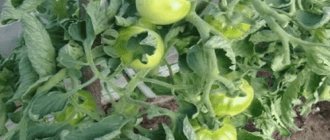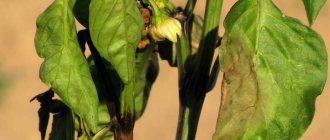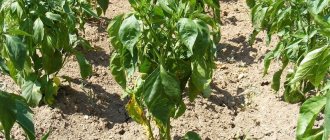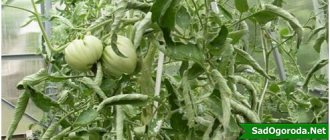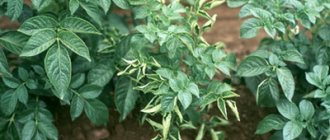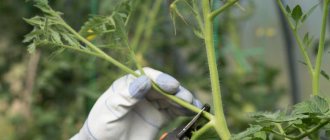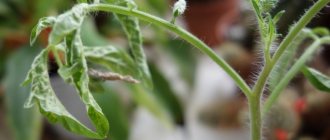Tomatoes will stop being capricious if you give them enough attention: provide them with the necessary lighting, heat, moisture, and get rid of diseases. It is necessary to help the plant resist insidious viruses, bacteria and fungi. They lead to wilting of the green mass of tomatoes and damage to the berries.
Gardeners often complain that the leaves of tomato seedlings wither, what to do about this and how to correct the unsightly position of the plant. We will talk about this in the article.
Plant diseases
First of all, it must be said that despite the climate suitable for growing tomatoes in the country, these plants themselves are quite capricious and require constant care. Tomatoes are especially susceptible to diseases that can spread in various ways. Some of these diseases will only damage the plants themselves (for example, leaves will fall off), others will affect the entire crop. To treat a disease, you need to detect its symptoms as quickly as possible and begin to eliminate the causes of their occurrence. Wilted plant tops are a symptom of several diseases at once. This is how a plant that suffers from late blight, phomosis and mosaic can react. In addition, excessive watering and excessive humidity can also cause tomato leaves to wilt. Sometimes insects can cause the top to wilt.
Accordingly, each disease must be dealt with in its own way. If the top withers due to the actions of voracious bugs (mole crickets, wireworms and other pests), then you need to use chemicals to combat them. If the cause of wilting is late blight (and greenhouse plants usually suffer from it), then the fight against it should be carried out differently. The fact is that this disease is fungal. It manifests itself not only in the fact that the top of the tomato withers, but also in brown spots on the leaves and stems of the plant. An additional symptom of the disease may be a white coating, located mainly on the lower leaves of the tomato.
Weather
If the beginning of summer was cold, then the soil did not have time to warm up well. And the subsequent sharp warming to abnormal heat provoked the evaporation of moisture by plants. In such a situation, the root system does not have time to quickly respond to changes, and even despite its accelerated absorption of water and nutrients, this occurs much more slowly than their evaporation. As a result, due to a lack of water and nutrition in the vessels of the plant, the water column ruptures and the part of the bush above the rupture site withers. In such a situation, experienced tomato growers advise feeding the leaves with preparations with a high potassium content. These are, for example, humic fertilizers, potassium nitrate or potassium sulfate, used according to the instructions.
If the fertilizer you have requires application at the root, and not along the leaves, reduce its concentration by 2-3 times, dissolve it well in water and apply foliar feeding.
Prevention measures
It is worth protecting tomatoes from disease ahead of time by carrying out special procedures to support them:
- It is necessary to plant only those tomatoes that initially look strong and healthy.
- Before planting seedlings, the soil must be balancedly fertilized. A lack of nutrients can cause plants to get sick often and not produce a good harvest.
- When planting tomatoes and caring for them (watering and fertilizing), you should avoid various damage to the crop, even minor ones.
- Dried nettle leaves can be placed in the holes with seedlings - it is believed that this particular plant helps the healthy development of tomatoes.
- The time of planting will also affect their further development. Therefore, weather and temperature conditions must be taken into account.
- It is optimal to plant several varieties at once in one area.
- A certain distance between plants must be maintained.
- You should not plant tomatoes in the same place every year. Experts advise planting tomatoes in one area at least once every four years.
- If the greenhouse is created exclusively for tomatoes, then the soil in it should be changed annually or the greenhouse premises should be moved to a new location.
- The soil on which diseased plants grew must be disinfected before planting, otherwise late blight will take hold of the leaves in the new year.
Lack of moisture
Tomatoes can withstand short-term drought; excess moisture is worse for them. But for full development, the watering regime is every 3-4 days. Signs of lack of fluid:
- the leaves on the tomato are curled into a “boat”;
- the seedlings wither;
- the stems may fall to the ground.
Moisten the tomato with soft water at room temperature. It is necessary to wet the entire earthen lump in the boxes so that excess water pours into the pan (it must be drained).
Causes of diseases
Basically, tomatoes wither for two reasons: due to improper care and due to poor growing conditions. These reasons can be boiled down to three points:
- overheat;
- lack of light;
- poor quality watering.
In some cases, the tops wither due to several points at once. With this option, an integrated approach must be taken to remove symptoms.
Poor watering
Tomatoes are very dependent on how they are watered. They wilt if the process starts to go against their needs. However, overwatering can be just as harmful as underwatering. Tomatoes may begin to dry out or rot. Excess moisture can lead, oddly enough, to wilting. Tomatoes need to be watered according to their development period. For example, young seedlings need daily watering; and it is advisable to carry it out early in the morning, before the sun rises too much above the ground. For picked seedlings, watering for several days is suitable. Depending on how quickly the soil dries out. Mature plants will only need watering once a week. However, the tomatoes should be watered abundantly.
Growing in a cold place
Growing in a cold room is one of the reasons why tomato seedlings wither. When the air temperature in the room is below +16 degrees, tomatoes stop growing. Their leaves curl with their edges down, and the color changes from green to a leaden hue.
Combined with high humidity, fungal diseases develop rapidly. They contribute to withering.
Drafts are also dangerous for delicate plants, especially for seedlings standing on the windowsill. Icy air coming from window cracks inhibits the development of roots, and they are less able to absorb nutrition from the soil.
The opposite situation, when the room is too hot, also harms pets. Tomatoes may turn yellow and wilt.
The optimal temperature for tomato seedlings should be between +22 +24 degrees during the day and +18 degrees at night.
Diseases
Wilting of the crowns can be caused by bacteria and pathogenic fungi. Bacterial diseases are very easy to identify. They are identified by small brown spots with light edges. Foliage with such signs gradually withers and dries out. To prevent the sprouts from wilting, it is necessary to use special preparations containing copper.
The most common fungal disease of tomatoes is fusarium wilt. Signs that the sprouts are affected are:
- upper shoots withering for no apparent reason;
- foliage that has changed color from the usual green to yellow;
- curling and falling leaves.
Prevention
To avoid such a disease in tomato beds, it is necessary to carry out prevention:
- Before planting the crop, the soil is disinfected with a solution of potassium permanganate;
- the tools used for excavation work are kept clean;
- seeds are treated before planting.
If signs of fusarium wilt still appear in the beds, it is necessary to treat the vegetable crops with special preparations, including Fitosporin and Trichodermin.
The tops of tomatoes are withering in the greenhouse. Help, tell me what to do!
Elena Chernikova
Maybe cover it with acrylic?
larysa lymar
wither from the sun. and in the evening if there is enough water they come to life
Alexander Rozhko
most likely this is late blight Use any drug that has a stop effect Thanos, Quadris (one package per 5 liters of water) or Infinito + immunocytophyte (2.5 tablets per 5 liters of water) + some kind of systemic insecticide (Decis, Aktara, imidacloprid ) + microelements + urea (150-200 g per 5 liters of water) and spray the tomatoes with all this in 2 days you won’t recognize them
Temperature changes
Temperature changes negatively affect seedlings
Tomatoes are a very heat-loving crop, so wilting and yellowing of the plant’s leaves may be associated with temperature changes.
To create comfortable conditions for tomato sprouts during the daytime, it is recommended to maintain the temperature between 22 and 30°C. At night, the thermometer should not fall below 12°C. The difference between daytime and nighttime thermometer readings cannot exceed 5°C.
To avoid problems, it is better to grow the crop in a greenhouse: it is much easier to regulate the air temperature under the film.
Curling and wilting foliage can be a result of extreme heat. To reduce the impact of high temperatures on crops growing in open ground, gardeners recommend constructing canopies.
In the fight against heat in a greenhouse, ventilation of the room helps, otherwise condensation will collect under the film cover, which in large quantities can harm the tomato beds.
What to feed when flowers fall
If tomatoes are just blooming, but the fruits are not set, or even worse, they begin to fall off, what should you do? It is necessary to create optimal conditions. The greenhouse should have moderate humidity, good ventilation, adequate nutrition, and a temperature not lower than plus 15 degrees.
If it is impossible to create such conditions, then boric acid can save flowers from falling: 5 g per 10 liters of water. This solution must be watered or sprayed.
In order for the fruit to set better, it is necessary to spray the brushes with Betaxon. Dilute 1 ml of Betaxon (not more) in 1 liter of water, pour into a spray bottle:
- Put a rubber glove on your left hand to protect the leaves from getting the drug.
- Hold the tomato brush by your hand, spray the solution once, but not 2 or 3 times, but only once.
- Take another brush, spray the solution and go around all the brushes.
This treatment will help set fruit from each flower on the tassel.
Violation of agricultural technology
With a very high concentration of salts in the soil, irregular watering, unbalanced fertilizing and untimely treatments, the crop can wither, starting from the very top. It is important to understand what exactly is happening to the plant, and based on this, provide it with proper assistance.
Pathological conditions of tomatoes
These include, in particular, dropsy of tomatoes, the appearance of aerial roots and cracks on the stems. Pathological changes occurring in the crop can also provoke wilting of the tops, since in all of these cases moisture and minerals do not reach the plant’s growth point in full or, conversely, the bush is oversaturated with them.
An issue that is worth considering separately is the wilting of the tops of tomatoes with the simultaneous curling of leaves on the entire plant. There can be just as many reasons for this, and, unfortunately, not all of them are fixable.
